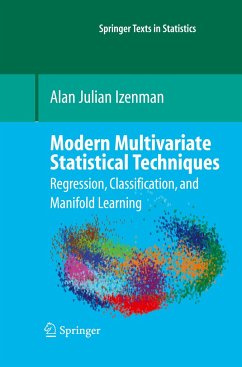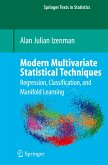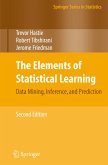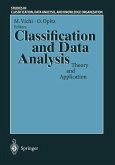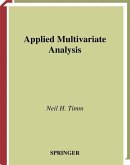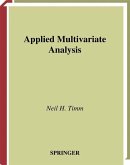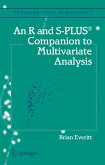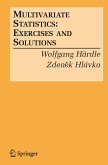Remarkable advances in computation and data storage and the ready availability of huge data sets have been the keys to the growth of the new disciplines of data mining and machine learning, while the enormous success of the Human Genome Project has opened up the field of bioinformatics.
These exciting developments, which led to the introduction of many innovative statistical tools for high-dimensional data analysis, are described here in detail. The author takes a broad perspective; for the first time in a book on multivariate analysis, nonlinear methods are discussed in detail as well as linear methods. Techniques covered range from traditional multivariate methods, such as multiple regression, principal components, canonical variates, linear discriminant analysis, factor analysis, clustering, multidimensional scaling, and correspondence analysis, to the newer methods of density estimation, projection pursuit, neural networks, multivariate reduced-rank regression, nonlinear manifold learning, bagging, boosting, random forests, independent component analysis, support vector machines, and classification and regression trees. Another unique feature of this book is the discussion of database management systems.
This book is appropriate for advanced undergraduate students, graduate students, and researchers in statistics, computer science, artificial intelligence, psychology, cognitive sciences, business, medicine, bioinformatics, and engineering. Familiarity with multivariable calculus, linear algebra, and probability and statistics is required. The book presents a carefully-integrated mixture of theory and applications, and of classical and modern multivariate statistical techniques, including Bayesian methods. There are over 60 interesting data sets used as examples in the book, over 200 exercises, and many color illustrations and photographs.
These exciting developments, which led to the introduction of many innovative statistical tools for high-dimensional data analysis, are described here in detail. The author takes a broad perspective; for the first time in a book on multivariate analysis, nonlinear methods are discussed in detail as well as linear methods. Techniques covered range from traditional multivariate methods, such as multiple regression, principal components, canonical variates, linear discriminant analysis, factor analysis, clustering, multidimensional scaling, and correspondence analysis, to the newer methods of density estimation, projection pursuit, neural networks, multivariate reduced-rank regression, nonlinear manifold learning, bagging, boosting, random forests, independent component analysis, support vector machines, and classification and regression trees. Another unique feature of this book is the discussion of database management systems.
This book is appropriate for advanced undergraduate students, graduate students, and researchers in statistics, computer science, artificial intelligence, psychology, cognitive sciences, business, medicine, bioinformatics, and engineering. Familiarity with multivariable calculus, linear algebra, and probability and statistics is required. The book presents a carefully-integrated mixture of theory and applications, and of classical and modern multivariate statistical techniques, including Bayesian methods. There are over 60 interesting data sets used as examples in the book, over 200 exercises, and many color illustrations and photographs.
From the reviews:
"This book will be enjoyed by those who wish to understand the current state of multivariate statistical analysis in an age of high-speed computation and large data sets. ... persons interested in learning new trends of multivariate methods would find Izenman's book very helpful. ... The full-color graphics is quite impressive - well done! There are numerous real-data examples from many scientific disciplines so that not only statisticians may find this book useful and interesting." (Simo Puntanen, International Statistical Review, Vol. 76 (3), 2008)
"The book describes how to manage data for maintaining and querying large databases. ... I recommend this book for advanced students in statistics and related profiles as, computer science, artificial intelligence, cognitive sciences, bio-informatics, and the involved different branches of engineering. More than 60 data sets are used for working out as examples. More than 200 exercises are presented in the book." (J. A. Rouen, Revista Investigación Operacional, Vol. 30 (2), 2009)
"For the first time in a book on multivariate analysis, nonlinear as well as linear methods are discussed in detail. ... Another unique feature of this book is the discussion of database management systems. This book is appropiate for advanced undergraduate students, graduate students, and researchers in statistics, computer science, artificial intelligence, psychology, cognitive sciences, business, medicine, bioinformatics and engineering. ... The book presents a carefully-integrated mixture of theory and applications, and of classical and modern multivariate statistical techniques, including Bayesian methods." (T. Postelnicu, Zentralblatt MATH, Vol. 1155, 2009)
"This monograph provides a comprehensive account of the development of multivariate statistical analysis powered by the explosion in the capability and speed of computers during the last four decades. It is written by an expert inthe field. The book is suitable for very advanced undergraduate students and graduate students in statistics, but can also be used in a host of other areas ... where statistics plays a major role. ... Any researcher in multivariate statistical analysis should have this book in his personal library." (Steen Arne Andersson, Mathematical Reviews, Issue 2010 b) "...Exemplifies the transition of statistical science as a scientific discipline focused on testing to one focused on information and knowledge discovery. ...Acknowledges in a novel way the link between statistical science and computer science, artificial intelligence, and machine learning theory...This book implements an overhaul for teaching multivariate analysis..." (The American Statistician, February 2010, Vol. 64 No.1)
"The author of this well-written, encyclopaedic text of roughly 730 pages highlights data mining using huge data sets and aims to blend 'classical' multivariate topics (such as regression, principal components and linear discriminant analysis, clustering, multi-dimensional scaling and correspondence analysis) with more recent advances from the field of computational statistics (such as classification and regression trees, neural networks, support vector machines or topics around committee machines-bagging, boosting and random forests). It is noteworthy that some of the more classical methods are derived as special cases of a common theoretical framework: reduced rank regression, a field to which Professor Izenman already has contributed with his doctoral thesis back in 1972. ...Furthermore it is worth noting as well that the first chapter after the introductory overview deals with data, databases and database management-indicating the author's seriousness about data analysis in the presence of permanently growing magnitudes of data sets to analyse. ...Most chapters end with sections on software packages, and all chapters end with bibliographical notes and exercises;the final list of references contains 552 entries. ...Personally, I felt the book to be heavy, yet rewarding, reading. It seems to have full potential to become a second standard reference next to Hastie et al. (2009)." (Journal of the Royal Statistical Society)
"In Modern Multivariate Statistical Techniques, Alan Izenman attempts to synthesize multivariate methods developed across the various literatures into a comprehensive framework. The goal is to present the current state of the art in multivariate analysis methods while attempting to place them on a firm statistical basis. ...This book would be a fantastic reference for researchers interested in learning about multivariate and machine learning methods. ...The first half of the book would be suitable for an advanced undergraduate or graduate multivariate analysis course. The second half of the book would be a great reference for a machine-learning course. I definitely enjoyed reading the book." (Biometrics, Summer 2009, 65, 990-991)
"This remarkable book exposes a wide range of techniques from the 'statistical learning' perspective. It is addressed to readers with a background in probability, statistical theory, multivariate calculus, linear algebra and notions of Bayesian methods. ... The exercises at the end of each chapter propose both theoretical derivations and practical work with real data. ... It can be used as a basis for different advanced courses. The first chapters can be employed for an introduction to modern prediction methods." (Ricardo Maronna, Statistical Papers, Vol. 52, 2011)
"This book will be enjoyed by those who wish to understand the current state of multivariate statistical analysis in an age of high-speed computation and large data sets. ... persons interested in learning new trends of multivariate methods would find Izenman's book very helpful. ... The full-color graphics is quite impressive - well done! There are numerous real-data examples from many scientific disciplines so that not only statisticians may find this book useful and interesting." (Simo Puntanen, International Statistical Review, Vol. 76 (3), 2008)
"The book describes how to manage data for maintaining and querying large databases. ... I recommend this book for advanced students in statistics and related profiles as, computer science, artificial intelligence, cognitive sciences, bio-informatics, and the involved different branches of engineering. More than 60 data sets are used for working out as examples. More than 200 exercises are presented in the book." (J. A. Rouen, Revista Investigación Operacional, Vol. 30 (2), 2009)
"For the first time in a book on multivariate analysis, nonlinear as well as linear methods are discussed in detail. ... Another unique feature of this book is the discussion of database management systems. This book is appropiate for advanced undergraduate students, graduate students, and researchers in statistics, computer science, artificial intelligence, psychology, cognitive sciences, business, medicine, bioinformatics and engineering. ... The book presents a carefully-integrated mixture of theory and applications, and of classical and modern multivariate statistical techniques, including Bayesian methods." (T. Postelnicu, Zentralblatt MATH, Vol. 1155, 2009)
"This monograph provides a comprehensive account of the development of multivariate statistical analysis powered by the explosion in the capability and speed of computers during the last four decades. It is written by an expert inthe field. The book is suitable for very advanced undergraduate students and graduate students in statistics, but can also be used in a host of other areas ... where statistics plays a major role. ... Any researcher in multivariate statistical analysis should have this book in his personal library." (Steen Arne Andersson, Mathematical Reviews, Issue 2010 b) "...Exemplifies the transition of statistical science as a scientific discipline focused on testing to one focused on information and knowledge discovery. ...Acknowledges in a novel way the link between statistical science and computer science, artificial intelligence, and machine learning theory...This book implements an overhaul for teaching multivariate analysis..." (The American Statistician, February 2010, Vol. 64 No.1)
"The author of this well-written, encyclopaedic text of roughly 730 pages highlights data mining using huge data sets and aims to blend 'classical' multivariate topics (such as regression, principal components and linear discriminant analysis, clustering, multi-dimensional scaling and correspondence analysis) with more recent advances from the field of computational statistics (such as classification and regression trees, neural networks, support vector machines or topics around committee machines-bagging, boosting and random forests). It is noteworthy that some of the more classical methods are derived as special cases of a common theoretical framework: reduced rank regression, a field to which Professor Izenman already has contributed with his doctoral thesis back in 1972. ...Furthermore it is worth noting as well that the first chapter after the introductory overview deals with data, databases and database management-indicating the author's seriousness about data analysis in the presence of permanently growing magnitudes of data sets to analyse. ...Most chapters end with sections on software packages, and all chapters end with bibliographical notes and exercises;the final list of references contains 552 entries. ...Personally, I felt the book to be heavy, yet rewarding, reading. It seems to have full potential to become a second standard reference next to Hastie et al. (2009)." (Journal of the Royal Statistical Society)
"In Modern Multivariate Statistical Techniques, Alan Izenman attempts to synthesize multivariate methods developed across the various literatures into a comprehensive framework. The goal is to present the current state of the art in multivariate analysis methods while attempting to place them on a firm statistical basis. ...This book would be a fantastic reference for researchers interested in learning about multivariate and machine learning methods. ...The first half of the book would be suitable for an advanced undergraduate or graduate multivariate analysis course. The second half of the book would be a great reference for a machine-learning course. I definitely enjoyed reading the book." (Biometrics, Summer 2009, 65, 990-991)
"This remarkable book exposes a wide range of techniques from the 'statistical learning' perspective. It is addressed to readers with a background in probability, statistical theory, multivariate calculus, linear algebra and notions of Bayesian methods. ... The exercises at the end of each chapter propose both theoretical derivations and practical work with real data. ... It can be used as a basis for different advanced courses. The first chapters can be employed for an introduction to modern prediction methods." (Ricardo Maronna, Statistical Papers, Vol. 52, 2011)

